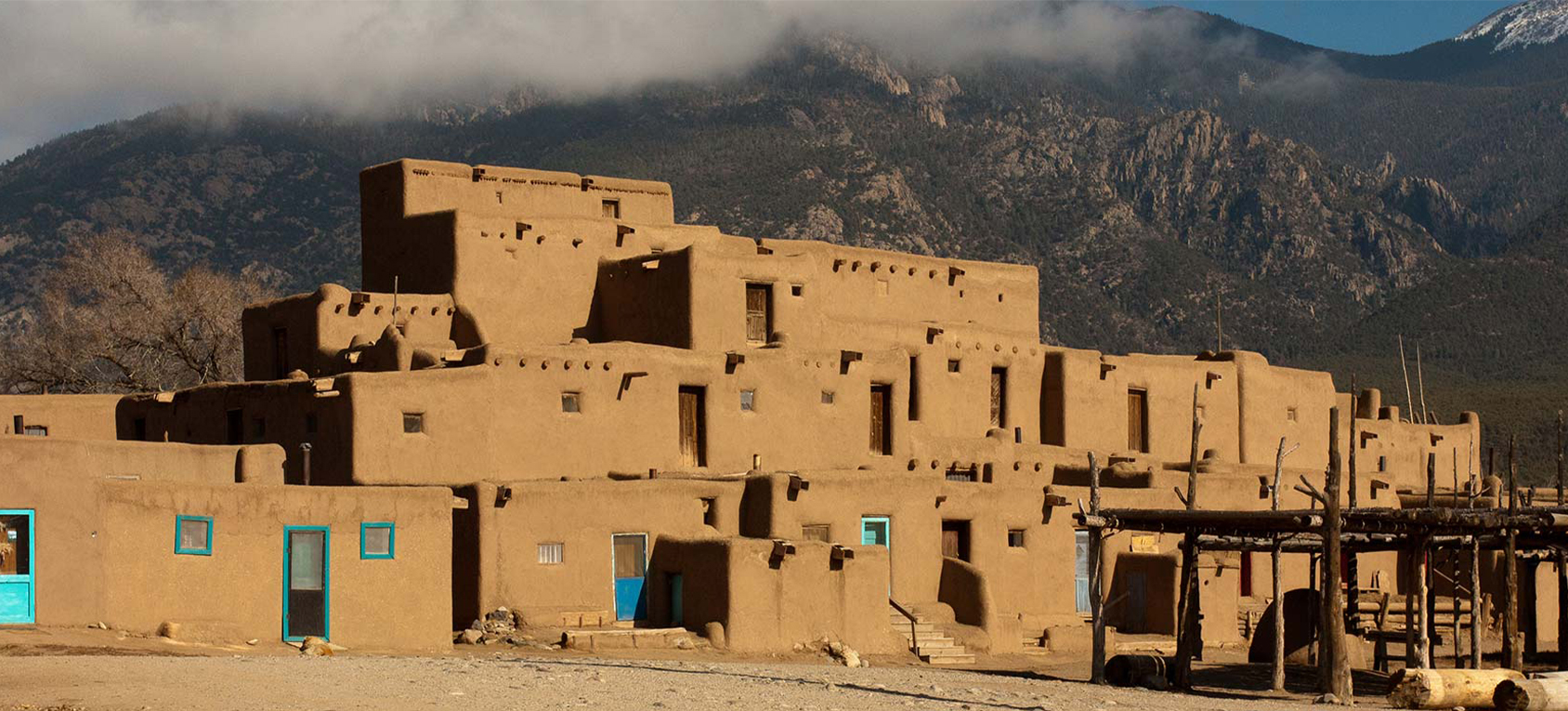
New Mexico spans a series of intersections. In North Central New Mexico, the Rocky Mountains end in upswells like the Sangre de Cristo mountains. New Mexico is also home to part of the Continental Divide. Water on the west side of the Divide runs towards the Pacific Ocean. Water on the east side runs towards the Atlantic, Arctic, and Gulf of Mexico. But perhaps the most fascinating set of intersections in New Mexico are the many peoples who call this great State home.
Many in New Mexico talk about the Tri‑Cultural population of the State.
Twenty‑three Indian tribes make their home here. In addition to the nineteen Pueblos such as Acoma, Laguna, and Isleta, three Apache tribes, and the Navajo nation live here. Many of these peoples, like those of the Zuni, the Taos, and the Laguna have lived in New Mexico for over a thousand years.
The Pueblo Indians range from the rather isolated Acoma that sits atop a mesa, to the Isleta, to the Ohkay Owingeh Pueblo whose artistic focus is pottery, weaving, and painting. The Taos Pueblo sits at the base of the Taos Mountains and Pueblo Peak soars to over 12,000 feet above the Pueblo. The area is so beautiful that the artists’ colony of Taos sprang up nearby.
The Jicarilla Apache Tribe was nomadic for centuries and settled in the Northern Sangre De Cristo Mountains just before contact with Europeans. The Mescalero Apache Tribe were known to be skilled strategists and fierce warriors. The Fort Sill Apache Tribe, whose governmental headquarters is in Oklahoma, established a presence in New Mexico in 2011.
The Navajo nation has almost 300,000 members. Over 100,000 Navajo people live in New Mexico, and the Nation’s boundaries extend into Arizona and Utah. The Navajo Nation’s governing body has evolved into one that is like the majority of democracies of the world with Legislative, Judicial, and Executive Branches. The Nation’s flag and symbol highlight the corn that is the Nation’s life’s blood and the cow, sheep, and horse that are the Nation’s livestock. The partial circles recognize and symbolize the sovereignty of this proud and dignified people.
The second third of the Tri‑cultural composition of the people of New Mexico, are the Europeans. When the Europeans arrived in New Mexico, they changed the lives and the trajectory of the State forever. Although the Spanish Conquistadors didn’t find the legendary cities of gold they had been seeking, they did find many indigenous people they wanted to convert to Catholicism. At the Pueblo Revolt of 1680, the indigenous people overthrew their colonizers and destroyed Missions and churches. After several years, the Spanish came back and succeeded in their mission to colonize and convert the indigenous people by tolerating the people’s spiritual practices and rituals alongside Catholicism.
Spanish and Hispanic influences suffuse New Mexican culture. Many people from Mexico and other Hispanic countries traveled El Camino Real, the Royal Road, between Mexico City and Santa Fe. People made the journey north and brought mining and smithing techniques to the indigenous people.
Many Hispanic influences remain in New Mexico. Architecture, folk and contemporary art, and clothing highlight the Hispanic influences on New Mexico’s culture and art scenes. Further, New Mexico has the highest percentage of Spanish‑speakers of any other State in the USA.
Today, almost fifty percent of New Mexico’s population is Hispanic. In addition to the Hispanos in the north of the State, many people from Latin and Central America also make New Mexico their home. Many in New Mexico share ties with the Aztec peoples, and this unique amalgam of cultures and history has created a way of life unlike any other.
Anglo traders and trappers who began working in the region make up the last third of the tri‑cultural composition of New Mexico. Also, artists and writers explored their fascination with the region and still contribute to the glorious art of New Mexico to this day.
Although, European influence and history can be clearly felt, in the make‑up of the people and cultures in New Mexico, the Native peoples of the Pueblos, Apache, and Navajo provide the crux of history and culture in the State. Their struggles, dignity, and perseverance contribute to the fiber that makes the State of New Mexico great.
https://www.newmexico.org/places-to-visit/native-culture/pueblos-tribes-nations/
https://www.crossingworlds.com